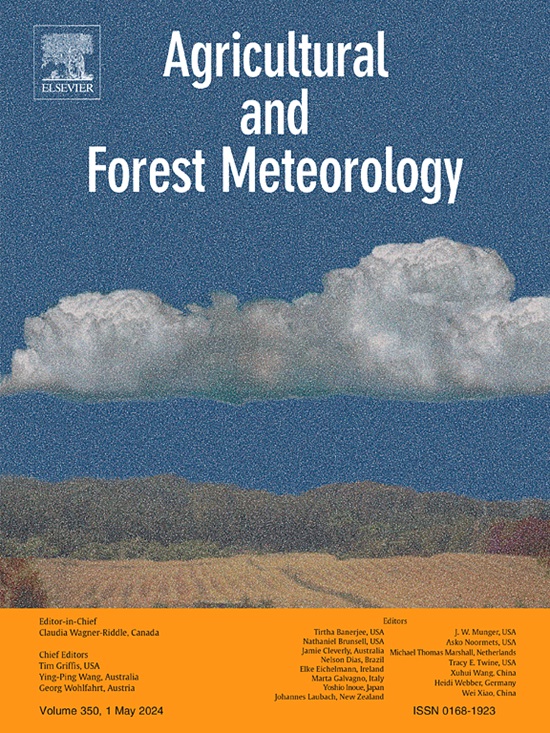A combined effect of heat and drought limits the growth of Central European silver fir
IF 5.6
1区 农林科学
Q1 AGRONOMY
引用次数: 0
Abstract
Prolonging drought periods and more extreme heatwaves limit tree species adaptation to environmental changes. Silver fir (Abies alba, Mill.) has been considered one of the species suitable for forest ecosystem adaptation and mitigation strategies in future climate conditions. Here, we present a dendroecological study of the joint effects of droughts and heatwaves on the radial growth of silver fir. We sampled tree-ring width series of 105 dominant individuals collected between 2016 and 2019 across the region of Western Carpathians on the elevational gradient of 200 – 1480 m a.s.l. The results suggest a rapid growth decline (∼1.00 cm2.year-1) of dominant individuals since the mid-1990s compared to the growth release during the 1980′s. A combined approach of absolute and relative temperature thresholds for heatwave quantification revealed a more frequent combination of severe heatwaves and droughts after 2000, especially in the lower and middle parts of the elevation gradient. Furthermore, we found an increasingly negative joint effect of drought and heatwaves on the growth of silver fir. We revealed statistically significant (p < 0.05) growth reduction (>25 %) during years with the joint effect of severe droughts and severe heatwaves on both the upper and lower edges of silver fir’s vertical distribution. Individuals growing at higher elevations experienced a significant growth reduction at a lower absolute temperature threshold (∼30 °C) compared to individuals growing in the lower parts of the Western Carpathians, where this reduction occurred at a higher absolute temperature threshold (∼35 °C). Our findings reveal heatwaves as an important ecological factor that should be considered in future dendroecological studies.
炎热和干旱的共同影响限制了中欧银杉的生长
延长的干旱期和更极端的热浪限制了树种对环境变化的适应。银杉(Abies alba, Mill.)被认为是在未来气候条件下适合森林生态系统适应和减缓战略的树种之一。本文对干旱和热浪对银杉径向生长的共同影响进行了树木生态学研究。我们对2016年至2019年在喀尔巴阡山脉西部地区收集的105个优势个体的树轮宽度系列进行了采样,海拔梯度为200 - 1480 m a.s.l。结果表明,与20世纪80年代的生长释放相比,自20世纪90年代中期以来,优势个体的生长迅速下降(约1.00 cm2.年-1)。热浪量化的绝对和相对温度阈值组合方法显示,2000年以后严重热浪和干旱的组合更加频繁,特别是在高程梯度的中下游地区。此外,我们发现干旱和热浪对银杉生长的共同负面影响越来越大。我们发现有统计学意义的(p <;在严重干旱和严重热浪的共同作用下,银杉垂直分布的上、下边缘均出现了生长下降(> 25%)。与生长在喀尔巴阡山脉西部较低地区的个体相比,生长在较高海拔的个体在较低的绝对温度阈值(~ 30°C)下经历了显著的生长减少,在那里这种减少发生在较高的绝对温度阈值(~ 35°C)下。我们的研究结果表明,在未来的树木生态学研究中,热浪是一个重要的生态因素。
本文章由计算机程序翻译,如有差异,请以英文原文为准。
求助全文
约1分钟内获得全文
求助全文
来源期刊
CiteScore
10.30
自引率
9.70%
发文量
415
审稿时长
69 days
期刊介绍:
Agricultural and Forest Meteorology is an international journal for the publication of original articles and reviews on the inter-relationship between meteorology, agriculture, forestry, and natural ecosystems. Emphasis is on basic and applied scientific research relevant to practical problems in the field of plant and soil sciences, ecology and biogeochemistry as affected by weather as well as climate variability and change. Theoretical models should be tested against experimental data. Articles must appeal to an international audience. Special issues devoted to single topics are also published.
Typical topics include canopy micrometeorology (e.g. canopy radiation transfer, turbulence near the ground, evapotranspiration, energy balance, fluxes of trace gases), micrometeorological instrumentation (e.g., sensors for trace gases, flux measurement instruments, radiation measurement techniques), aerobiology (e.g. the dispersion of pollen, spores, insects and pesticides), biometeorology (e.g. the effect of weather and climate on plant distribution, crop yield, water-use efficiency, and plant phenology), forest-fire/weather interactions, and feedbacks from vegetation to weather and the climate system.

 求助内容:
求助内容: 应助结果提醒方式:
应助结果提醒方式:


